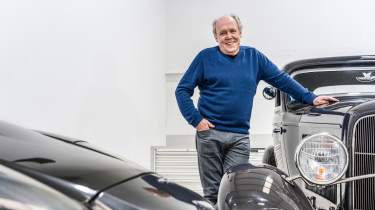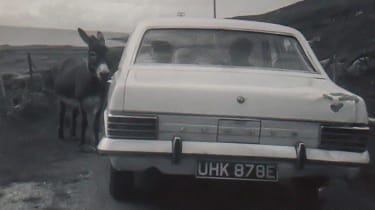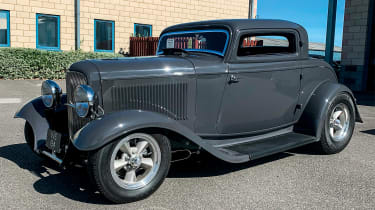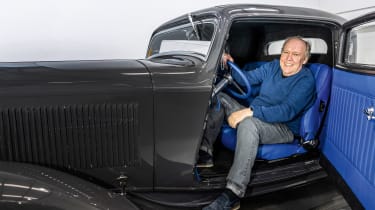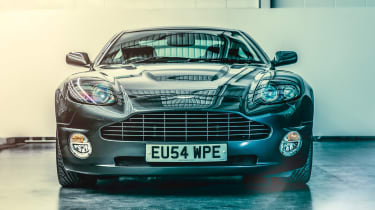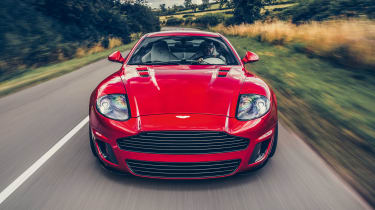My Life & Cars – Ian Callum, designer and car collector
Best-known for his designs for Aston Martin and Jaguar, Ian Callum looks back over a distinguished career and talks about his own eclectic collection of cars
You know you’re going to get on well with Ian Callum, designer of the Aston Martin DB7, Vanquish and DB9, and for 20 years design boss at Jaguar, when he tells you he once had a Sierra RS Cosworth as a company car while simultaneously owning a Citroën 2CV. ‘I loved that Cosworth, oh my goodness,’ enthuses Callum.
There was a certain amount of envy from the softly spoken Scot’s fellow managers at Ford, he recalls. ‘A lot of the guys asked: “How have you got that?” So I said that I’d just filled in some forms and ordered it and they could do the same. They said: “But we can’t afford it.” I replied: “I can’t afford it either!”
> Aston Martin Callum Vanquish 25 by R-Reforged 2022 review
‘But I was a genuine car guy and I simply had to have that Cosworth. I had it for about a year and a half and went everywhere in it. It was just amazing. You were supposed to return it after six or nine months with no more than 10,000 miles on them. I kept getting letters from the company car guys saying that I had to return it – this went on for ages and I eventually handed it back with 30,000 miles on it, so I got my money’s worth.’
Callum’s fascination with cars and his passion for drawing them emerged from a very young age, he recounts. ‘From the age of about three I would draw stuff around the house – TV sets, radios, mechanical things. Then one day I decided that I loved cars. I think my grandfather may have had something to do with that as he had a keen interest in them and encouraged me. At our house in Dumfries I used to stand at the gate at the bottom of the garden and watch all the cars go by.
‘One day I saw a Porsche 356 drive past, a silver one, and I realised it was something remarkable and to my eyes very beautiful. I remember on my first day at primary school telling my teacher that when I grow up I’m going to be a car designer. She looked at me rather condescendingly and sent me back to my desk.’
There would be many setbacks in achieving that goal, but Callum had utter conviction car design was his destiny. ‘That certainty turned my younger years into a race – I had to get through all this other stuff so that I could go off and do what I really wanted to do. School was a formality I had to put up with. My school was academically driven so the idea that I wanted to study art instead of French baffled them.
‘I told them I wanted to take art and engineering, but for the life of them they couldn’t understand the connection. So I used to say to them that perhaps they should go and ask Leonardo da Vinci about it.’
With a degree of prescience, in 1968, aged 14, Callum sent some of his designs to William Heynes, Jaguar’s technical director: Heynes’ reply confirmed the need for further education in art and engineering. Explaining his interest in Jaguars, Callum says: ‘In my youth Jaguars were the most exotic cars that somehow seemed attainable. And the E-type was the essence of style. It was an inspiration and made me want to create very stylish cars. Later on, that thought was always emotive for me as a Jaguar designer, as I tried to educate people that Jaguar is about style first and foremost.’
Regular school done and dusted, Callum enrolled at the School of Transportation and Design in Coventry, though it would prove a disheartening experience. ‘There was a fuel crisis going on and we were discouraged from designing cars,’ Callum sighs. ‘They wanted us to design other forms of transport, stuff like rollerskates, so I got little car education or car design training. Peter Stevens [car designer and now a good mate of Callum’s] came in a couple of times to show us how to draw cars, but against the backdrop of the time, it felt almost politically incorrect.’
A year into ‘this disappointing experience’ Callum quit and returned to Scotland where he did an art course in Aberdeen and then an industrial design course at the Glasgow School of Art. ‘That saved me,’ he confesses. ‘I spent three fantastic years at Glasgow and got back into my car design. I produced some good projects with thought-provoking ideas behind them.’
With his talent now shining, Callum earned sponsorship from Ford to attend the Royal College of Art’s automotive design course in London. But Callum reveals that he’d actually been hoping for a job with Vauxhall. ‘In those days Wayne Cherry was running the show at Vauxhall and had done things like the Firenza and the SRV concept car, an incredible piece of design. So I tried getting a job there and was even endorsed by Cherry to go to the Arts Centre California [America’s answer to the RCA], but Vauxhall was reluctant to employ me at that time.’
While studying at the RCA, Callum acquired his first car. ‘It was a Volvo P544 that I bought from Peter Stevens, who was a lecturer at the RCA. He’d hot-rodded the car and it had proper American mag wheels on it, although it didn’t have an engine. I found one and fitted it and thought that funny old Volvo was so cool.
‘But it only did 12 to the gallon so I couldn’t afford to run it. After that it was a Mini Clubman, 998cc, that I used to drive back to Scotland in. Then I had a Vauxhall Chevette, believe it or not. I’d fallen in love with the Chevette HS2300 – I couldn’t afford one of those but thought I could drop a 2.3 lump into a regular Chevette. You know what you’re like at that age, full of dreams…
‘A Morris Minor pickup with a Sprite engine was next, followed by a Beetle GT which again I bought off Peter Stevens – that was written off when a Mini crashed into it. I bought a Beetle convertible in Holland, did it up and then my wife and I toured Europe in it. Mad! When I joined Ford and tired of the labour that goes into old car ownership I bought a Mk1 XR2, which was a tremendous little car. I traded it in for a Mk2, a car I’d actually done some work on.’
By 1979 Callum was working full-time at Ford in Dunton, which wasn’t the dream job he’d envisioned. ‘It was a bleak, rainy day in Dunton, I’d just been given a steering wheel to design for the Transit, and I had a moment where I asked myself if this is really what I wanted to be doing. But it was all part of growing up. You go through that phase in your late teens and early 20s where you’re fighting with life and you want to make sure you fulfil your dreams properly.’
Those clouds of gloom dispersed when Callum devised a cunning plan. ‘I learnt how to make a noise – the squeaky wheel gets the most oil…
I didn’t moan so much as make the point that I should be doing exterior design, it’s what I need to do. So what they did was ship me around the world: I don’t know if that was to give me experience or just to get rid of me.
‘I ended up working in Australia, in Japan and in Italy, where I was manager at Ghia. Ford looked after me very well and the experience was invaluable. You learnt how to design things at a cost – style is very important to a company like Ford because the cars sell as much on style as substance. Because the cars are relatively inexpensive you have to maximise the effect of the metal and interior as much as you can for the buck.’
After enjoying the fun and glamour of his life at Ghia in Turin, an eventual return to Dunton and a Mondeo steering wheel design was a deal-breaker for Callum and in 1990 he took a job with Tom Walkinshaw at TWR to establish a design studio. ‘Tom was Scottish so we got on really well,’ laughs Callum. ‘And he was very aesthetically astute so realised that a design studio would be a shop window for the company’s engineering talents.
‘When ex-colleagues from Ford came to see me in my little TWR industrial unit in Oxford I could see their questioning looks, but I remember saying to them: “Don’t judge me on this, judge me by what comes out the other end.” And we did some great cars at TWR – the Aston DB7 was the making of me. The Vanquish then cemented my reputation.’
Largely because of the Vanquish, in 1999 Ford’s global head of design, J Mays, who was shaking up the Ford group’s design pool, poached Callum to be chief designer at Jaguar. ‘When I arrived at Jaguar my first work was actually the DB9 [at the time Jaguar and Aston were both Ford-owned], which I was glad to do because a lot of the new Jaguar stuff was already done for the next five years.’
Initially involved with facelifts and derivatives of existing models, by 2006 Callum and his team started to reveal to the world Jaguar’s new design language. First out of the traps was the XK, followed at frequent intervals by the XF, all-new XJ, F-type, XE, F-Pace and I-Pace, a prodigious output interwoven with facelifts and show-stopping concept cars. With hindsight we can wonder at the scale of that achievement, but Callum reveals that not all the designs were well-received internally. ‘To me the XK was very much part of the traditional Jaguar family, a good follow-up to the XK8, but a couple of the executives did not like that car at all because it had “sharp edges” on it.’
In 2019, after two decades steering the design direction of Jaguar, Callum stepped down from the role. That was also the year he was awarded a CBE ‘for services to the British car industry’. Interestingly, in my two lengthy conversations with the Scot, he never once mentions his gong, which may be modesty or could be because he much prefers talking about cars.
He doesn’t just talk about them, he owns them. ‘I’ve bought cars I wanted when I was younger but couldn’t afford. My XJ Coupe, for example, which is such a beautiful thing. I always hankered after a 911 and the 993 was one of my favourites. It’s modified to be more like an RS. And I’ve got a TR6, uprated, which is the car I drive most.
‘I’ve loved hot-rods since I was a teenager, so have a Ford Model B hot-rod and an old Chevy C10 pickup truck. I’ve had numerous rubbish Minis but in 1995 I bought a year-old car that I still have. I owned a Mk1 Escort RS2000 for a while, and a genuine Chevette HS2300 too. I’ve also got an Alfa Giulia coupe, which is being built up with a twin-spark engine. I’m building a 2.2 Porsche 914, too, which is proving to be a pain in the arse.
‘I’ve got a VW T6 van which I’ve lowered, put big 20in wheels on it. Oh, and I’ve got a Vanquish as well,’ says Callum, suddenly remembering one of his greatest designs. ‘My Mk2 Jaguar restomod was a labour of love. It was built by Classic Motor Cars to an extraordinarily high specification. We tried to turn it into a business but it was too expensive. I had to sell my car to recoup development costs – literally hundreds of thousands. Shame, it was a fantastic bit of kit.’
Rather than retire, in 2020 Callum launched a design and engineering consultancy called, appropriately, Callum. One of its first creations is the Vanquish 25, a fresh take on the V12-engined Aston coupe, which has been thoroughly updated visually and mechanically, inside and out. ‘When I started Callum I wanted to expand our portfolio beyond just cars, into areas such as furniture, for instance. And we’re now working on a fairly eclectic mix of projects such as a lounge chair and others that I can’t really talk about.
‘But with that goal well under way, I’m relishing doing more car work again, such as the recent Prodrive Hunter T1+ and a few more you will see soon.’ His younger self would thoroughly approve.
This story was first featured in evo issue 294.
